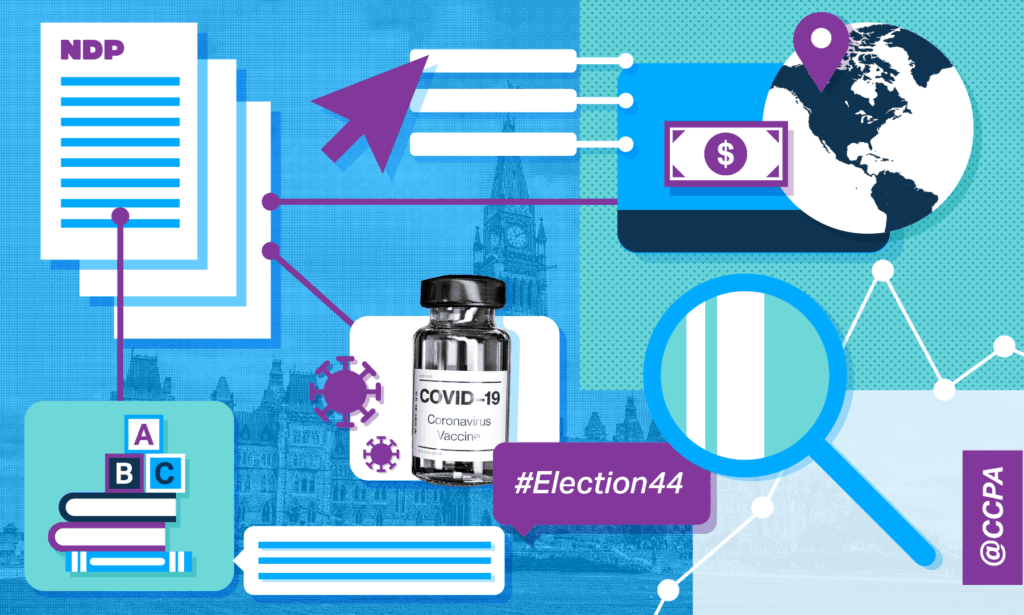The Green Party is next up to the plate with its election pitch, releasing a 103-page uncosted platform that focuses on the themes of a green future, life with dignity, and a just society.
The uncosted platform is, however, long on ambition but short on details.
Climate emergency
True to its name, the Green Party’s climate platform is more ambitious than any of the other parties’ plans.
Most importantly, the party commits to the complete phase-out of bitumen (oil sands) production by 2035 as part of a plan to more broadly phase out oil and gas. The Liberals and NDP have acknowledged emissions from the sector but neither has committed to a firm end date.
The Greens also promise to raise the national carbon pricing floor to $265 per tonne by 2030, well above the Liberal plan of $170 per tonne in that timeframe.
Those two policies alone would put Canada well on its way to meeting the Greens’ new emissions reduction target of 60% below 2005 levels by 2030—a target that is consistent with Canada’s fair share of global reductions. On this measure, the Green Party platform is the only one to align its ambitions with the warnings of climate scientists.
The Green platform also places a significant focus on environmental justice and the imperative of a just transition. It promises retraining for fossil fuel workers, new green jobs for young workers and community-led transition plans, all of which are key pillars of a sustainable and inclusive economy.
However, like the NDP, the Greens have not provided costing nor details for the majority of their climate change promises. Terms like “support”, “promote” and “ensure” are liberally used without explanation.
The ambiguities are most pronounced in the area of green infrastructure. While the goal of 100% renewable electricity by 2030 is laudable, for example, what will it cost? Since the platform precludes further nuclear power, which other technologies will it prioritize? And will the goal be achieved through public investment, regulation, subsidies to the private sector or some other mechanism?
COVID-19 response
To prepare for future pandemics, the Greens have proposed: creating an intergovernmental rapid response task force for future emergencies, lessening dependence on global supply chains for essential goods, providing long-term funding for the Public Health Agency of Canada for surge capacity, and investing in research and production of vaccines and medical treatments.
Like the other parties, the Green platform also commits to ensuring sufficient PPE stockpiles and “robust capacity” for pharmaceutical manufacturing, though it is unclear if the party would take a public- or private-led approach.
Comparatively, the NDP has committed to making vaccine production a public entity, while the Conservatives appear to be choosing the private path by partnering with pharmaceutical companies (an approach that was taken this year by the federal government when it announced agreements with two U.S.-based vaccine manufacturers to produce COVID-19 and mRNA vaccines in Canadian facilities).
The Green platform also commits to reversing biodiversity loss and species extinction, drawing a link between biodiversity decline and its likelihood to increase the frequency and severity of pandemics.
The Green platform makes no mention of mandating vaccines for passengers of interprovincial trains, commercial flights, cruise ships, and the federal public service, as the Liberal platform does. The NDP has also come out in favour of requiring vaccines for federal workers, as well as domestic vaccine passports. By comparison, the Conservative platform outlines a plan that wouldn’t require vaccination, but would require unvaccinated public servants to take daily rapid COVID-19 tests and unvaccinated plane and train passengers would have to take a rapid test before boarding. Rapid testing provisions are not included in the Green platform either, although it does commit to ensuring COVID-19 testing for staff, family caregivers, and residents in long-term care.
Care economy
While the Greens are best known for their climate focus, their platform does promote a series of universal and progressive social policies to expand and strengthen Canada’s care economy—a critical task that has been made self-evident during the course of this pandemic.
Like the NDP, the Greens promise to expand the scope and impact of Canada’s health care system, bringing in universal dental care and universal pharmacare. The Greens would launch pharmacare next year by providing coverage for a list of essential medicines, with the program slated to be fully up and running by 2025.
The Greens are also pledging to bring long-term care under the Canada Health Act and to introduce, as the Liberals and NDP are also proposing, a set of “enforceable” national care standards to ensure quality care, along with “transformative investments” in both home care and facility care for infrastructure and better wages and working conditions for staff.
To this end, the Greens would create a dedicated Seniors’ Care Transfer to provinces and territories, which would be separate from other health transfers, and target funds to boost the proportion of long-term care investment in community and home-based care.
Like the NDP, the Greens propose to end for-profit long-term care facilities. Decades of research in Canada and abroad have demonstrated the damaging impacts of privatization within health care and other essential services—as measured by higher costs, long wait times for essential services, and the loss of crucial resources and health care workers to the private system.
The Green platform is in favour of universal child care but, unlike long-term care it does not stress public or non-profit delivery. It's not clear how their proposal would differ from the plan presented in the spring 2021 federal budget to introduce $10-a-day child care by 2026 and to cut fees in half by 2022. The Greens are proposing to ramp up federal child care funding to achieve the international benchmark of at least one per cent of GDP annually, tying this funding to a set of guiding principles (as the current bilateral Early Learning and Child Care Agreements do). But it’s not clear if the Greens abandon the new bilateral agreements negotiated this summer as the Conservative Party plans to.
Workers, EI and a guaranteed livable income
Following the pandemic, there was plenty of support sent to individuals and the jobless to keep them and the economy afloat. As fear of the fourth wave mounts, it's important to examine what changes the Green Party might make to the Employment Insurance (EI) system and other income supports. The Greens would boost EI payments, cover social assistance costs of the provinces in favour of a guaranteed livable income, but the details are vague.
Details matter. Like what is the basic income level, who will receive it, what is the clawback rate, and how will it integrate with pre-existing basic income programs? In contrast, the Liberal and Conservative platforms have pushed the expansion of the Canada Workers Benefit (Liberals in the spring budget, Conservatives in their platform).
Trade
Way down on page 87, we come to the Greens’ “international fair trade policy,” though proposals for trade reform can also be found elsewhere in the platform. Overall, this is a more detailed vision than what other parties have presented. Some of the Green Party’s proposals can also be found in the NDP, Conservative and Liberal plans, while others are unique.
First off, what does the party mean by “fair” trade? We have to ask, since both U.S. President Joe Biden and former president Donald Trump both frequently use the term.
For the Green party, a “fair” trade policy is one directed toward “the promotion of environmental, social and governance principles, a more egalitarian regime for the exchange of intellectual property and clean technologies, and a narrowing of the equality gap between high- and low-income countries.” A “fair” trade policy for the NDP “broadens opportunity in all areas of the country, while protecting our industries and upholding labour standards, environmental protections and human rights around the world.”
The Liberal platform, in comparison, refers to “trade that works for everyone,” which sounds similar to “fair” trade on the surface. However, where the NDP and Greens would seek reforms to trade policy and trade agreements, the Liberal government and the Liberal platform assume the agreements are fine as is and focus on procedural changes to encourage small-, women- and Indigenous-owned businesses to engage more in international commerce. The Liberal platform promises to negotiate more classic free trade deals in Latin America and Asia, albeit with “inclusive” provisions on gender equality that are generally not enforceable.
The Greens propose that we “Increase bilateral trade, where possible, to facilitate the export of value added products from small island economies.” Though this policy is not elaborated, it’s possible the party is thinking of something like the U.S. Generalized System of Preferences, which grants preferential treatment to imports from developing countries and least developed countries that meet certain standards set by the U.S. government. That can be beneficial where the standards may boost labour rights abroad or potentially harmful where the conditions relate to the adoption of one-size-fits-all intellectual property rights or regulatory regimes that can stunt sustainable economic development and value-added production.
Another similarity between the NDP and Green platforms is a carbon border adjustment mechanism, CBAM, as proposed by the European Union and the Biden administration, and as being studied by the Liberal government. A CBAM is essentially a tariff on imports that are higher in carbon than Canadian-made products. The main goal, according to the Green Party, is to “ensure Canadian companies paying carbon taxes are not placed at a competitive disadvantage with foreign companies located in countries with no such taxes.” Also in common with the NDP, the Greens propose a “green procurement” or “Buy Sustainable” policy to increase government spending on low-carbon, Canadian-made building materials and finished goods.
The CCPA has supported “Buy Sustainable” policies as an alternative to “Buy Canadian” conditions on public procurement. We’re talking about them in a trade section because “Buy Canadian” policies, for most government entities down the municipal and school board level, are now prohibited in Canada (in most circumstances) due to concessions made by the former Conservative federal government and signed off on by the Liberal government in our free trade deal with the European Union. In a flip-flop, the Conservatives now want to introduce “Buy Canadian” procurement policies for PPE and other strategic goods.
Internationally, the Green platform proposes to “revamp the World Trade Organization to the World Trade and Climate Organization,” which would be responsible for ensuring that trade is consistent with a global carbon budget. The mechanism appears to be tied to national tariffs based on the carbon intensity of imports (the CBAMs mentioned earlier). It’s not clear how this would be managed, but perhaps the calculations for determining country carbon budgets (and therefore import and export allowances) would be set by the climate supercomputer proposed elsewhere in the Green platform.
Both the NDP and Greens would also eliminate investor–state dispute settlement from Canadian trade and investment deals and cease negotiating new agreements that include these increasingly controversial corporate rights provisions.
Housing
In an earlier analysis, we argued that the housing platforms of the NDP, Liberals and Conservatives had many similarities, particularly their heavy focus on homeownership and underwhelming promises around affordable housing.
The Greens’ platform stands out in its focus on renters, proposing a national moratorium on evictions for the remainder of the pandemic. This federal election is taking place while COVID-19 cases climb again, federal emergency income supports are being cut by 40%, and police are forcefully dismantling homeless encampments across the country. This is the only platform that mentions evictions and proposes to halt them. Given that rents keep going up during the pandemic, the platform could have coupled an eviction ban with a rent freeze, which would go further in supporting the financial and housing security of tenant families.
The Greens’ platform also proposes to create national standards to establish rent and vacancy controls. By doing so, it named the elephant in the room. Stopping rents from rising faster than inflation and wages is the most direct way of improving rental housing affordability.
The number of affordable housing units that the Greens propose to build or acquire (300,000) doesn’t stand out in relation to what the other parties propose. But the wording does. The party describes it as “deeply affordable, non-market, co-op and non-profit housing.” Unfortunately, the party fails to define “deeply affordable,” which could have elicited a helpful and much-needed debate about what housing affordability means.
The platform also proposes to require housing developments that receive federal funding to ensure that “30% of units in each development must be deeply affordable and/or available to people with disability and special needs.” It is unclear why this is an and/or and not simply an and, given that people with disability are overrepresented among the share of the population living on low income. Still, this is the only platform to name the issue.
One bullet point somewhat buried in the proposal contains the boldest housing proposal seen in this election: “Re-focus the core mandate of the Canada Mortgage and Housing Corporation (CMHC) on supporting the development of affordable, non-market and cooperative housing.” This would revert the current emphasis on supporting lenders, which CMHC does by assuming part of the risk of the loans circulating in the housing market. This measure, coupled with the proposal to appoint a Minister of Housing to work directly with provincial governments, would create an institutional setting more akin to what we had in the 1960s and 1970s, the heydays of rental and social housing construction in Canada. If backed with the right amount of funding and political will—and these are big ‘ifs’—this institutional shift could put the country on the right track.
The Greens’ platform unapologetically states that, “individual home ownership should not be the preoccupation of a public service housing agency and a national housing strategy.” This level of support to tenants is not seen in any other platform in this election.
Education
The Green Party’s platform is by far the most aspirational of the other parties when it comes to post-secondary education. Rather than promising to eliminate interest on student debt, introducing a targeted debt forgiveness program, or increasing the minimum threshold for repayment, it proposes to abolish post-secondary tuition, at a cost of approximately $10.2 billion annually, to be partially financed by redirecting existing spending on tuition tax credits (projected at $1.945 billion in 2021), saved costs of administering the student loan system, and eliminating the cost of student loan defaults written off every year ($138 million in 2019). However, there is no information about how much the cost of eliminating tuition will be offset by these measures. There is also no discussion about the process by which federal funding will be allocated to eliminate tuition fees, which range in 2021 from about $3,000 in Newfoundland and Labrador to over $9,000 in Nova Scotia for undergraduates, due to the sliding scale of provincial investment (or lack thereof).
Additionally, the Green platform commits to eliminating all federally held student debt (estimated in 2020 at over $22 billion); reintroducing an enhanced Canada Emergency Student Benefit, retroactive to May 1 and available to all international and recently graduated students; and allocating an additional $10 billion “to post secondary and trade school supports.”
The platform also commits to removing the 2% cap on funding for Indigenous students, increasing the number of Canada Graduate Scholarships for graduate and doctoral students, and increasing the training benefit. All of this is positive, but the plan is short on details.
It mentions making Canada a destination of choice for international students, but is unclear about reducing the exorbitant tuition fees they are charged—fees that have been steadily increasing as public funding grows increasingly insufficient. Statistics Canada estimates that international students paid almost 40% of all tuition fees in 2017/18 and accounted for almost $4 billion in annual revenue for Canadian universities.
There is also no mention of the increasing reliance of universities and colleges on contract faculty and other precariously employed workers on campuses across the country.
Taxation/fiscal considerations
In terms of how promises might be paid for, there is plenty of selection in the Green platform (although none of it is costed). On corporate income taxes (CIT), the party proposes raising it from 15% federally to 21%, the rate that existed prior to the Liberal rate cuts of the mid-2000s. It wants to hold the small business rate at 9% though, where it has been since 2019. In addition to increasing the general rate, they are looking to create a surcharge of 5% on banks. This is not dissimilar to the Liberal proposal levied on the same industry, although at a lower rate. Given that the CIT cuts of the mid-2000s didn’t lead to the promised corporate investment, the CIT hike is a fine idea in order to fund other needed priorities. A financial transactions tax of 0.5% is another means of slowing speculative trading in the financial sector while raising revenue.
There is a strong focus on ensuring international corporations don’t use creative accounting to get around paying Canadians taxes. One of the ways in which companies do that is through transfer pricing, where their affiliate in Bermuda (or other tax haven) incurs the profit, but since the CIT is 0% or close to it, they pay no taxes instead of paying the proper taxes in Canada. A test to determine if that company in Bermuda is anything more than a P.O. box, i.e. a functioning business, is a good place to start. Working on a global minimum tax is another approach, both of which are part of the Green platform.
The Greens also propose to collect tax from transnational digital companies that offer services in Canada but pay no taxes. However, it's not clear how this would differ from the 3% tax on Canadian revenue that was instituted in the spring budget.
Like the NDP, the Greens are proposing a wealth tax. The plan would also close the stock option deduction, although this was already limited to $200,000 in July. It appears that they’d fully eliminate it. There is also a move to full inclusion of capital gains. This would be a positive move in equalizing tax treatment, although they may consider an inflationary adjustment. There is a proposed new luxury tax on cars and planes, but this tax was already implemented in the spring federal budget.
Although uncosted, these tax measures have the potential to raise significant revenue to offset new spending.
Reconciliation
The Green platform promises the following key actions to support Indigenous reconciliation, among others:
Implementing the Truth and Reconciliation Commission’s recommendations and calls to action, as well as the UN Declaration on the Rights of Indigenous Peoples;
Providing funding for new and existing Indigenous Healing Centres;
Work towards an “Indigenous Lands and Treaties Tribunal Act” that would establish an independent body to decide on specific claims;
Transition out of the Indian Act, “guided by Indigenous leadership”;
End all drinking water advisories;
And “formally repudiate the doctrine of terra nullius, the doctrine of discovery,” which was used for centuries as legal and moral justification for colonial dispossession of sovereign Indigenous Nations, including in what is now called Canada.
As in the NDP and Liberal platforms, the Greens devote considerable space to addressing Indigenous issues as part of what is needed for Canada to truly move forward on truth and reconciliation. While much of the Conservative’s Indigenous commitments focus on the economy and resources—including passing legislation to make it illegal for protestors to block infrastructure, such as rail blockades, which could adversely impact Indigenous Peoples—they do make a commitment to fund an investigation of all former residential schools where unmarked graves may exist, as well as to developing a plan to implement some of the Truth and Reconciliation Commission’s calls to action.
As with the NDP, CPC and LPC platforms, CCPA researchers have analyzed the Green Party platform commitments and, where possible, we’ve compared those commitments across all party promises.

















